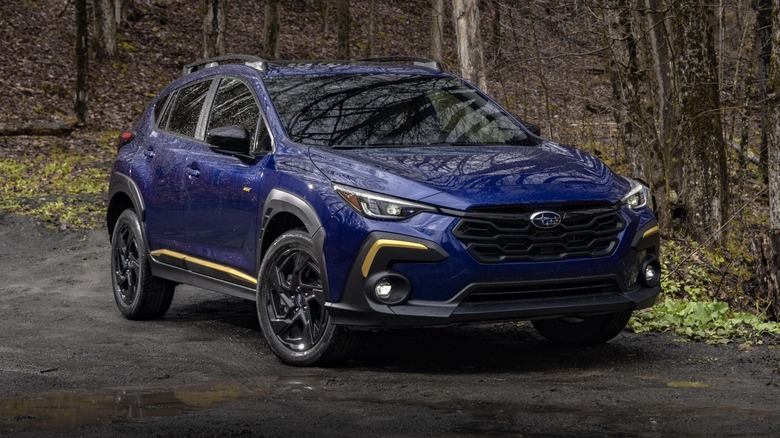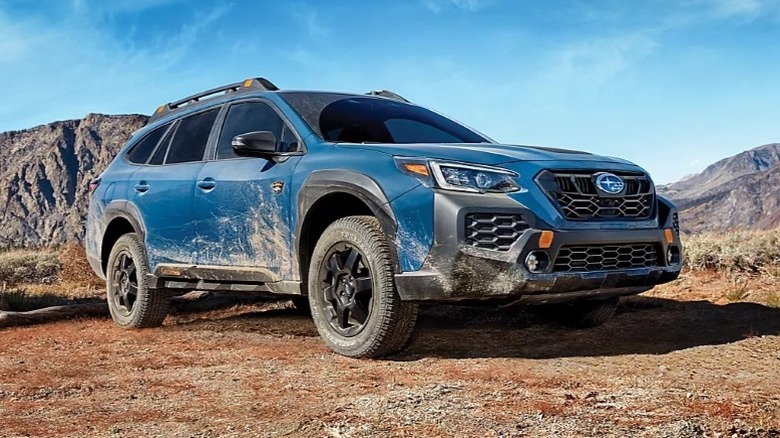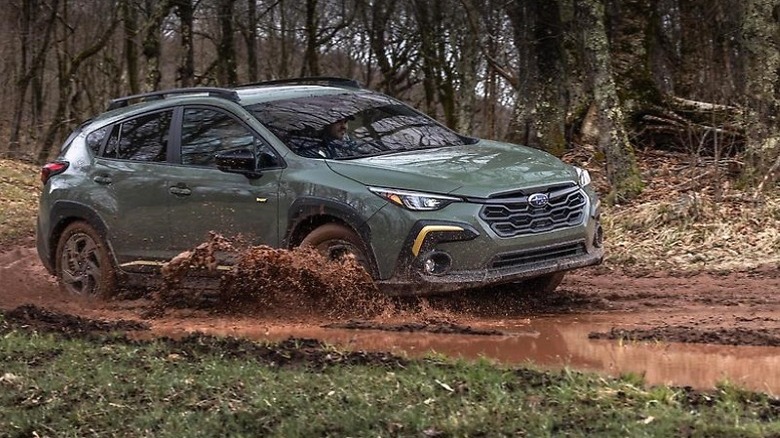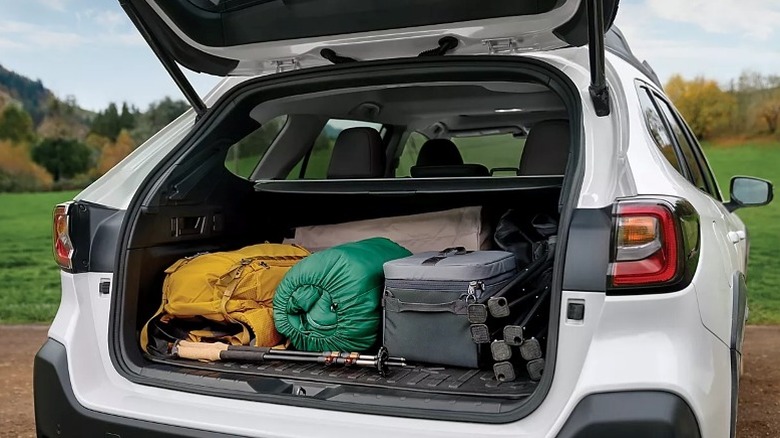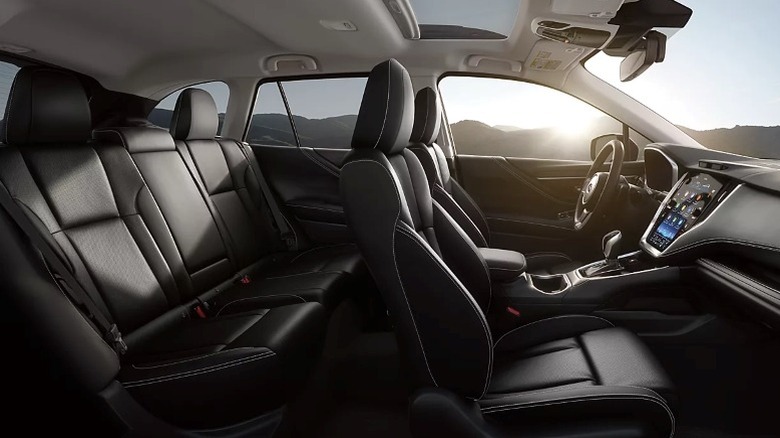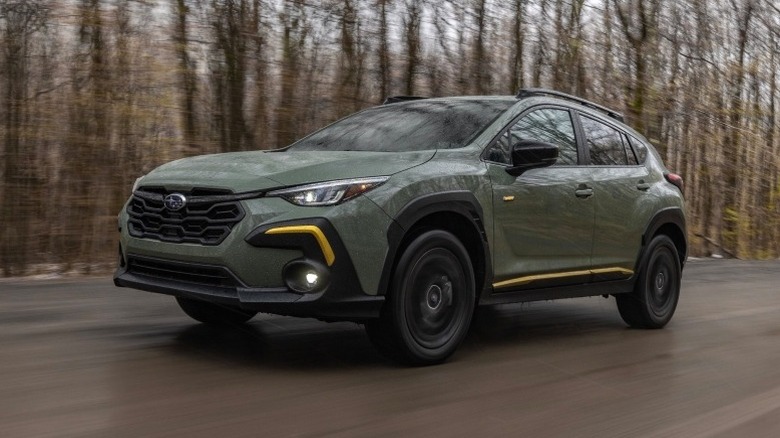Subaru Outback Vs. Crosstrek: What's The Difference Between These Crossovers?
The Subaru Crosstrek and Outback have a lot of appeal. They're the cheapest Subaru crossovers currently available for consumers, with the Crosstrek starting from $25,810, and the Outback beginning higher at $29,010. They also both offer standard all-wheel drive, rugged build quality, and remain largely faithful to adventure-loving families who might want to venture off the beaten track, thanks in part to their generous 8.7 inches of standard ground clearance.
A continuously variable automatic transmission (CVT), Subaru's EyeSight suite of driver assistance safety technologies, standard dual 7.0-inch screens, and an available 11.6-inch touchscreen are other features that are common to both Subaru SUVs. But there are just as many things that set them apart, including their interior and exterior dimensions, cargo space, and horsepower output. And with that in mind, we've compared the Subaru Outback and Crosstrek side by side to help you see how they measure up against each other.
What is the Subaru Outback?
The Subaru Outback is a station wagon with lifted ride height — even though Subaru prefers to ignore its wagonlike silhouette, opting instead to brand it as a midsize SUV. It began life in 1994 as a trim package for the Subaru Legacy wagon but has since grown into its own model, even though its wagonlike form remains. Current sixth-generation Outback models are based on the Subaru Global Platform (SGP), which also underpins nearly all other Subaru models, including the Subaru Legacy, which is due to end production after the 2025 model year.
Aside from sharing a similar platform, the Outback and Legacy still have many things in common, such as their horizontally opposed four-cylinder engines, continuously variable automatic transmission (CVT), and standard all-wheel-drive system. Due to its off-road capability, rugged looks, wagon styling, and utility, the Outback has been extremely popular with outdoorsy types who also appreciate its car-like ride quality. The numbers prove it as one of the best-selling Subaru vehicles in the U.S., with 3 million Outback units finding new homes between 1994 and 2024.
What is the Subaru Crosstrek?
The Crosstrek hit dealerships in 2013 and similar to how the Outback is a derivative of the Subaru Legacy, the Crosstrek is largely a raised Subaru Impreza hatchback. The compact SUV is currently in its third generation and continues to share core elements with the Impreza, including its base and optional engines, continuously variable automatic transmission (CVT), and standard full-time all-wheel drive system. It prides itself on being a competent daily driver, thanks to its useful cargo space, comfortable interior, and good fuel economy.
As a result, it is a great option whether you're in the market for a rugged, small crossover SUV that offers standard all-wheel, or desire a capable alternative to subcompact SUVs such as the Chevrolet Trax, Mazda CX-30, and Volkswagen Taos. Compared to the Subaru Outback, though, the Crosstrek does have a lot of catching up to do. But it certainly has its own merits, and you may find greater favor with it than the Outback, depending on what you're looking for in your next crossover.
The Subaru Outback makes more power than the Crosstrek
Most people today want more of the good stuff, and if for you, that extends to horsepower, then you'd likely go with a Subaru Outback over a Crosstrek. In standard form, the Outback's 2.5-liter four-cylinder engine puts out 182 horsepower and 176 lb-ft of torque. This engine can be found under the hood of the 2025 Subaru Outback Base, Premium, Onyx Edition, Limited, and Touring trims. If you find yourself wanting even more oomph, you can opt for the turbocharged 2.4-liter four-cylinder engine, which generates a whopping 260 hp and 277 lb-ft. This engine is standard on the Outback Touring XT, Limited XT, Wilderness, and Onyx Edition XT grades.
All Outback versions with the 260-hp turbo engine tow up to 3,500 pounds, while those with the naturally aspirated 182-hp, 2.5-liter four-cylinder are tow-rated at 2,700 pounds. Regardless, if you feel 182 hp is good enough and don't see the point in anything more, then the Subaru Crosstrek could also very well meet your needs. The base Crosstrek trim features a 2.0-liter four-cylinder engine that develops 152 horsepower and 145 lb-ft of torque, whereas the Subaru Crosstrek Wilderness, Premium, Sport, and Limited all have a 182-hp 2.5-liter four-cylinder. Maximum towing capacity for the Crosstrek is rated around 3,500 pounds with the Wilderness trim specified; all other trims are rated to tow 1,500 pounds max, no matter the engine beneath the hood.
How much cargo space do you need?
If off-road excursions are going to be a regular part of your routine, it can be helpful to have enough cargo space for hauling things like camping gear, mountain bikes, or outdoor equipment. In that case, the Subaru Outback with its generous cargo capacity is likely to impress you. It provides 32.6 cubic feet of room with all seats in use, which increases to 75.6 cubic feet if you drop the rear seats. With the Crosstrek being a smaller crossover, its cargo space is never going to beat that, but you still get a useful 19.9 cubic feet behind the second row (20.0 cubic feet in the Wilderness trim) and a maximum of 54.7 cubic feet with those seats lowered (54.9 cubic feet with the Wilderness trim).
Of course, the difference in carrying capacity is due to the Outback's bigger exterior dimensions. It rides on a 108.1-inch wheelbase, with 191.9 inches of overall length (191.3 inches for the Wilderness trim). The Outback is also relatively wider and taller, with its width and height coming in at 74.2 (74.6 inches for the Wilderness) and 66.1 inches (66.9 inches for the Outback Wilderness), respectively. In comparison, the Crosstrek has an overall length of 176.4 inches, width of 70.9 inches (71.7 inches for the Crosstrek Wilderness), wheelbase of 105.1 inches (104.9 inches for the Crosstrek Wilderness), and height of 62.8 inches (63.6 inches for the Crosstrek Wilderness).
Base ground clearance is similar, though, with both crossovers providing 8.7 inches. However, the Outback has a higher ground clearance in Wilderness specification at 9.5 inches, compared to 9.3 inches for the Crosstrek Wilderness.
What quality of interior materials do the Subaru SUVs offer?
On the face of it, the Subaru Outback and Crosstrek both have beautifully finished cabins with near similar features. Regardless of what model you choose, there's a standard dual 7.0-inch touchscreen setup on offer. And if that's not large enough, Subaru offers an available 11.6-inch touchscreen infotainment system that should please. However, the Outback is the one you want if you're after the finer things. The Touring and Touring XT, in particular, feature supple Nappa leather-trimmed upholstery, which should give higher seating comfort. These models also come with heated and ventilated front seats, heated rear seats, and a heated steering wheel.
While the Crosstrek offers heated front seats as standard in Sport, Limited, and Wilderness forms, it doesn't boast ventilated seats, heated rear seats, or Nappa leather upholstery. Instead, the Limited trim is the only option for standard leather seats. The Crosstrek Wilderness comes with water-repellent synthetic leather upholstery, while all the other trims feature Cloth upholstery. With the Outback, you get leather upholstery on the Limited and Limited XT, whereas the Outback Onyx Edition, Onyx Edition XT, and Wilderness all come equipped with water-repellent synthetic leather upholstery as standard. The Base and Premium grades are the only Outback trims with cloth seating.
What price fits your budget best?
As with any purchase decision, the choice between the Subaru Outback and Crosstrek ultimately comes down to what you can afford and how much you're willing to pay. The cheapest Outback is $3,200 costlier than the Base Crosstrek, and for $25,810 (msrp), the latter is mighty tempting when you consider what you get.
Even if you've got deep enough pockets, there are other Crosstrek trims that pile on the standard features, such as the Limited trim, which, at $31,510 is not a huge jump from the Outback's $29,010 base price. And for the price, the Crosstrek offers standard leather upholstery, heated front seats, power driver's seat, an 11.6-inch touchscreen infotainment system, a six-speaker sound system, and more. In addition to the Base and Limited trims, your other Crosstrek options include the Premium (starts from $27,060), Sport ($29,610), and the off-road-focused Wilderness ($32,610).
Obviously, the Outback wouldn't be as gentle on your wallet, but it's well worth considering if you want a turbo engine or something with more cargo space and higher-end materials, such as the Touring ($39,475) or Touring XT ($42,910), which both offer standard Nappa leather upholstery. You won't find Nappa leather anywhere else, but the other Outback trims also have the advantage of a spacious cargo area. They include the Premium ($31,310), Onyx Edition ($36,220), Limited ($37,970), Onyx Edition XT ($39,475), Wilderness ($39,960), and Limited XT ($40,310).
